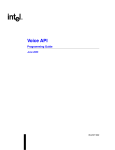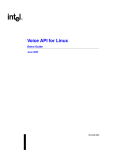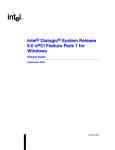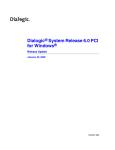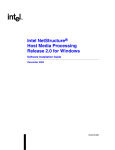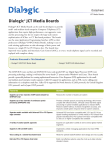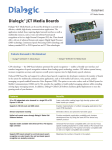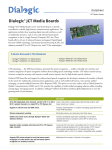Download Intel Sleep Apnea Machine 05-1850-004 User's Manual
Transcript
OA&M API for Linux Operating
Systems
Programming Guide
August 2005
05-1850-004
INFORMATION IN THIS DOCUMENT IS PROVIDED IN CONNECTION WITH INTEL® PRODUCTS. NO LICENSE, EXPRESS OR IMPLIED, BY
ESTOPPEL OR OTHERWISE, TO ANY INTELLECTUAL PROPERTY RIGHTS IS GRANTED BY THIS DOCUMENT. EXCEPT AS PROVIDED IN
INTEL'S TERMS AND CONDITIONS OF SALE FOR SUCH PRODUCTS, INTEL ASSUMES NO LIABILITY WHATSOEVER, AND INTEL DISCLAIMS
ANY EXPRESS OR IMPLIED WARRANTY, RELATING TO SALE AND/OR USE OF INTEL PRODUCTS INCLUDING LIABILITY OR WARRANTIES
RELATING TO FITNESS FOR A PARTICULAR PURPOSE, MERCHANTABILITY, OR INFRINGEMENT OF ANY PATENT, COPYRIGHT OR OTHER
INTELLECTUAL PROPERTY RIGHT. Intel products are not intended for use in medical, life saving, or life sustaining applications.
Intel may make changes to specifications and product descriptions at any time, without notice.
This OA&M API for Linux Operating Systems Programming Guide as well as the software described in it is furnished under license and may only be
used or copied in accordance with the terms of the license. The information in this manual is furnished for informational use only, is subject to change
without notice, and should not be construed as a commitment by Intel Corporation. Intel Corporation assumes no responsibility or liability for any
errors or inaccuracies that may appear in this document or any software that may be provided in association with this document.
Except as permitted by such license, no part of this document may be reproduced, stored in a retrieval system, or transmitted in any form or by any
means without express written consent of Intel Corporation.
Copyright © 2002-2005 Intel Corporation. All Rights Reserved.
BunnyPeople, Celeron, Chips, Dialogic, EtherExpress, ETOX, FlashFile, i386, i486, i960, iCOMP, InstantIP, Intel, Intel Centrino, Intel Centrino logo,
Intel logo, Intel386, Intel486, Intel740, IntelDX2, IntelDX4, IntelSX2, Intel Inside, Intel Inside logo, Intel NetBurst, Intel NetMerge, Intel NetStructure,
Intel SingleDriver, Intel SpeedStep, Intel StrataFlash, Intel Xeon, Intel XScale, IPLink, Itanium, MCS, MMX, MMX logo, Optimizer logo, OverDrive,
Paragon, PDCharm, Pentium, Pentium II Xeon, Pentium III Xeon, Performance at Your Command, skoool, Sound Mark, The Computer Inside., The
Journey Inside, VTune, and Xircom are trademarks or registered trademarks of Intel Corporation or its subsidiaries in the United States and other
countries.
* Other names and brands may be claimed as the property of others.
Publication Date: August 2005
Document Number: 05-1850-004
Intel Converged Communications, Inc.
1515 Route 10
Parsippany, NJ 07054
For Technical Support, visit the Intel Telecom Support Resources website at:
http://developer.intel.com/design/telecom/support
For Products and Services Information, visit the Intel Telecom Products website at:
http://www.intel.com/design/network/products/telecom
For Sales Offices and other contact information, visit the Where to Buy Intel Telecom Products page at:
http://www.intel.com/buy/wtb/wtb1028.htm
OA&M API for Linux Programming Guide – August 2005
Contents
Revision History . . . . . . . . . . . . . . . . . . . . . . . . . . . . . . . . . . . . . . . . . . . . . . . . . . . . . . . . . . . . . . 5
About This Publication . . . . . . . . . . . . . . . . . . . . . . . . . . . . . . . . . . . . . . . . . . . . . . . . . . . . . . . . 7
Purpose . . . . . . . . . . . . . . . . . . . . . . . . . . . . . . . . . . . . . . . . . . . . . . . . . . . . . . . . . . . . . . . .
Intended Audience . . . . . . . . . . . . . . . . . . . . . . . . . . . . . . . . . . . . . . . . . . . . . . . . . . . . . . . .
How to Use This Publication . . . . . . . . . . . . . . . . . . . . . . . . . . . . . . . . . . . . . . . . . . . . . . . .
Related Information . . . . . . . . . . . . . . . . . . . . . . . . . . . . . . . . . . . . . . . . . . . . . . . . . . . . . . .
1
7
7
7
8
Product Description . . . . . . . . . . . . . . . . . . . . . . . . . . . . . . . . . . . . . . . . . . . . . . . . . . . . . . . . . . . 9
1.1
1.2
1.3
1.4
OA&M API Overview . . . . . . . . . . . . . . . . . . . . . . . . . . . . . . . . . . . . . . . . . . . . . . . . . . . . . . 9
Features. . . . . . . . . . . . . . . . . . . . . . . . . . . . . . . . . . . . . . . . . . . . . . . . . . . . . . . . . . . . . . . 10
OA&M API Class Hierarchy . . . . . . . . . . . . . . . . . . . . . . . . . . . . . . . . . . . . . . . . . . . . . . . . 11
Event Notification Framework . . . . . . . . . . . . . . . . . . . . . . . . . . . . . . . . . . . . . . . . . . . . . . 11
2
Event Handling . . . . . . . . . . . . . . . . . . . . . . . . . . . . . . . . . . . . . . . . . . . . . . . . . . . . . . . . . . . . . . 15
3
Error Handling . . . . . . . . . . . . . . . . . . . . . . . . . . . . . . . . . . . . . . . . . . . . . . . . . . . . . . . . . . . . . . 17
4
Application Development Guidelines . . . . . . . . . . . . . . . . . . . . . . . . . . . . . . . . . . . . . . . . . . . . 19
4.1
4.2
4.3
5
General Guidelines . . . . . . . . . . . . . . . . . . . . . . . . . . . . . . . . . . . . . . . . . . . . . . . . . . . . . . 19
Designing CT Bus Clocking Applications. . . . . . . . . . . . . . . . . . . . . . . . . . . . . . . . . . . . . . 20
Designing High Availability into Applications . . . . . . . . . . . . . . . . . . . . . . . . . . . . . . . . . . . 20
Building Applications. . . . . . . . . . . . . . . . . . . . . . . . . . . . . . . . . . . . . . . . . . . . . . . . . . . . . . . . . 23
5.1
5.2
Compiling and Linking . . . . . . . . . . . . . . . . . . . . . . . . . . . . . . . . . . . . . . . . . . . . . . . . . . . .
5.1.1 Include Files . . . . . . . . . . . . . . . . . . . . . . . . . . . . . . . . . . . . . . . . . . . . . . . . . . . . .
5.1.2 Required Libraries . . . . . . . . . . . . . . . . . . . . . . . . . . . . . . . . . . . . . . . . . . . . . . . .
Variables for Compiling and Linking . . . . . . . . . . . . . . . . . . . . . . . . . . . . . . . . . . . . . . . . .
23
23
24
24
Index . . . . . . . . . . . . . . . . . . . . . . . . . . . . . . . . . . . . . . . . . . . . . . . . . . . . . . . . . . . . . . . . . . . . . . 25
OA&M API for Linux Programming Guide – August 2005
3
Contents
Figures
1
2
4
OA&M API Classes . . . . . . . . . . . . . . . . . . . . . . . . . . . . . . . . . . . . . . . . . . . . . . . . . . . . . . . . . . 10
Event Notification Framework. . . . . . . . . . . . . . . . . . . . . . . . . . . . . . . . . . . . . . . . . . . . . . . . . . . 12
OA&M API for Linux Programming Guide – August 2005
Revision History
This revision history summarizes the changes made in each published version of this document.
Document No.
Publication Date
Description of Revisions
05-1850-004
August 2005
General Guidelines section: Added information about freeing memory that is
allocated for object pointers.
05-1850-003
March 2005
Application Development Guidelines chapter : Added section about High Availability
®
development guidelines. High Availability is a feature of cPCI boards. The Intel
Dialogic® System Release 6.1 Feature Release 2 for Linux supports PCI and
cPCI boards.
05-1850-002
November 2004
Product Description chapter : Noted that the CTPLATFORMVERSIONINFO data
structure has been updated for the current release.
Noted that Springware architecture boards only generate events on the
NETWORK_ALARM_CHANNEL. DM3 architecture boards generate events on
all four event service channels.
Application Development Guidelines chapter : Removed section about High
Availability development guidelines. High Availability is a feature of cPCI boards.
The Intel® Dialogic® System Release 6.1 Feature Release 1 for Linux does not
support cPCI boards.
05-1850-001
September 2002
Initial version of document.
OA&M API for Linux Programming Guide — August 2005
5
Revision History
6
OA&M API for Linux Programming Guide — August 2005
About This Publication
The following topics provide information about this publication:
• Purpose
• Intended Audience
• How to Use This Publication
• Related Information
Purpose
This publication provides guidelines for building applications using the Operations, Administration
and Maintenance (OA&M) API. The OA&M API is used to create system management
applications (for example, a customized CT bus clocking daemon).
This publication is a companion guide to the OA&M API for Linux Operating Systems Library
Reference that provides details on the classes, functions, error codes and events in the OA&M
library.
Intended Audience
This publication is written for the following audience:
• Distributors
• System Integrators
• Toolkit Developers
• Independent Software Vendors (ISVs)
• Value Added Resellers (VARs)
• Original Equipment Manufacturers (OEMs)
How to Use This Publication
Refer to this publication after you have installed the hardware and the system software that
includes the OA&M API library.
This publication assumes that you are familiar with the Linux operating system and the C++
programming language. If you are developing a CT Bus management application, you should also
have a thorough understanding of CT Bus clocking concepts (Primary, Secondary and Network
Reference clock masters).
OA&M API for Linux Programming Guide — August 2005
7
About This Publication
The information in this guide is organized as follows:
• Chapter 1, “Product Description” provides an overview of the OA&M API.
• Chapter 2, “Event Handling” describes how to register with the OA&M event notification
framework and handle OA&M events.
• Chapter 3, “Error Handling” describes the exception handling capabilities provided by the
OA&M API.
• Chapter 4, “Application Development Guidelines” provides guidelines when developing
applications from the OA&M API.
• Chapter 5, “Building Applications” provides guidelines for building applications with the
OA&M API.
Related Information
Refer to the following documents and Web sites for more information:
• OA&M API for Linux Operating Systems Library Reference
• Intel® DM3 Architecture Products on Linux Configuration Guide
• Intel® Springware Architecture Products on Linux Configuration Guide
• Intel® Dialogic® System Release on Linux Administration Guide
• High Availability for Linux Operating System Demo Guide
• Intel NetStructure® IPT Series on Linux Configuration Guide
• System Release Guide
• System Release Update
• http://developer.intel.com/design/telecom/support/ (for technical support)
• http://www.ectf.org/ (for CT Bus clocking specifications)
8
OA&M API for Linux Programming Guide — August 2005
Product Description
1.
1
This chapter describes the OA&M API. The following topics are included:
• OA&M API Overview . . . . . . . . . . . . . . . . . . . . . . . . . . . . . . . . . . . . . . . . . . . . . . . . . . 9
• Features . . . . . . . . . . . . . . . . . . . . . . . . . . . . . . . . . . . . . . . . . . . . . . . . . . . . . . . . . . . . . 10
• OA&M API Class Hierarchy. . . . . . . . . . . . . . . . . . . . . . . . . . . . . . . . . . . . . . . . . . . . . 11
• Event Notification Framework . . . . . . . . . . . . . . . . . . . . . . . . . . . . . . . . . . . . . . . . . . . 11
1.1
OA&M API Overview
The classes and functions of the OA&M API support the development of applications that facilitate
the Operation, Administration, and Maintenance (OA&M) of Intel® Dialogic systems. For
example, you can create a system management application that monitors CT Bus clocking fault
events and automatically performs clock reference (Primary, Secondary, or Network Reference)
recovery without user intervention.
The classes in the OA&M API can be divided into the following three categories:
• System Component classes (CCTDomain, ICTNode, ICTBoard, ICTClockAgent). The
System Component classes allow you to instantiate objects that represent the various
components of your Intel® Dialogic system (domain, node, boards, clocking agents). After an
object has been instantiated, you can use the member functions of its class to
programmatically obtain, and in some cases change, the object’s attributes.
• Exception class (CCTDasiException). The exception class defines the exception objects that
can be generated by functions in the CCTDomain, ICTNode, ICTBoard, and ICTClockAgent
classes.
• Event notification framework classes (DlgAdminConsumer, CEventHandlerAdaptor). The
event notification framework classes allow you to instantiate objects that receive and process
OA&M events.
Figure 1 depicts the names and member functions of each class included in the OA&M API library.
OA&M API for Linux Programming Guide — August 2005
9
Product Description
Figure 1. OA&M API Classes
1.2
Features
The features available through the OA&M API include the following:
• Get version information (major release number, release build number, service pack number,
feature pack number, service update number, feature release number etc.) about the Intel®
Dialogic system software that is installed on a node (ICTNode class).
Note: The CTPLATFORMVERSIONINFO data structure has been updated as part of the
current system software release. To incorporate the updates, you must recompile any
existing application that uses the CTPLATFORMVERSIONINFO data structure or
the ICTNode::GetSystemReleaseVersionInfo( ) function. Refer to the OA&M API
10
OA&M API for Linux Programming Guide — August 2005
Product Description
for Linux Operating Systems Library Reference for information about the
CTPLATFORMVERSIONINFO data structure and the
ICTNode::GetSystemReleaseVersionInfo( ) function.
• Get physical identification information (serial number, PCI slot number, number of network
interface trunks, etc.) about individual DM3 architecture or Springware architecture boards
(ICTBoard class).
• Get the Addressable Unit Identifier (AUID) of an individual DM3 architecture or Springware
architecture board (ICTBoard class).
• Get the AUID of a board’s clocking agent (ICTClockAgent class).
• Get the TDM bus capabilities of a board's clocking agent (ICTClockAgent class).
• Get the TDM bus configuration of a board's clocking agent (ICTClockAgent class).
• Set the TDM bus configuration of a board’s clocking agent (ICTClockAgent class).
• Receive asynchronous OA&M events from the event notification framework
(DlgAdminConsumer class).
• Instantiate event handler objects. Event handler objects are invoked when DlgAdminConsumer
objects receive events from the event notification framework (CEventHandlerAdaptor class).
1.3
OA&M API Class Hierarchy
The System Component classes of the OA&M API (CCTDomain, ICTNode, ICTBoard, and
ICTClockAgent) are organized into a hierarchy as shown in Figure 1, “OA&M API Classes”, on
page 10. Since the CCTDomain class resides at the top of the class hierarchy, each application built
from the OA&M API must first instantiate a CCTDomain object as an entry point into the OA&M
system. You must then adhere to the class hierarchy as you instantiate other System Component
objects. For example, since the ICTClockAgent class resides at the bottom of the OA&M API class
hierarchy, you must instantiate and query all other System Component objects (CCTDomain,
ICTNode, ICTBoard) until you reach the ICTClockAgent class.
Refer to Chapter 4, “Application Development Guidelines” for procedural information about
instantiating CCTDomain, ICTNode, ICTBoard, and ICTClockAgent objects.
1.4
Event Notification Framework
The event notification framework is the Intel® Dialogic subsystem for sending asynchronous
OA&M events to applications. The framework is implemented using supplier objects, consumer
objects and event notification channels as shown in Figure 2:
OA&M API for Linux Programming Guide — August 2005
11
Product Description
Figure 2. Event Notification Framework
Application
(linked to libdlgadminconsumerfw.so for Linux)
(linked to libdlgadminconsumerfw.lib for Windows)
libdlgadminconsumerfw.so (Linux)
libdlgadminconsumerfw.lib (Windows)
Consumer
Objects
DlgAdminConsumer
object (registered
with ADMIN_CHANNEL)
DlgAdminConsumer
object (registered with
FAULT_CHANNEL)
NETWORK_ALARM_CHANNEL
FAULT_CHANNEL
CLOCK_EVENT_CHANNEL
Event
Notification
Channels
ADMIN_CHANNEL
Listening for
events
Supplying
events
Supplier
Objects
Intel
NetStructure
Series Board
Intel
NetStructure
Series Board
Intel
NetStructure
Series Board
Note: The CLOCK_EVENT_CHANNEL and NETWORK_ALARM_CHANNEL
are idle in the figure shown above. These two channels are available,
but do not have consumer objects registered to listen for events.
Intel® Dialogic system software components, such as device drivers and firmware, are the supplier
objects. They generate events that are broadcast to consumer objects via the event notification
channels. The DlgAdminConsumer class allows you to instantiate consumer objects and register
them to receive events from one of the event notification channels. The CEventHandlerAdaptor
class allows you to instantiate user-defined event handler objects that are invoked when
DlgAdminConsumer objects receive events.
12
OA&M API for Linux Programming Guide — August 2005
Product Description
The framework contains the following event notification channels, each of which carries specific
types of events:
• ADMIN_CHANNEL
• CLOCK_EVENT_CHANNEL
• FAULT_CHANNEL
• NETWORK_ALARM_CHANNEL
Notes: 1. DM3 architecture boards generate events on all four channels shown above. Springware
architecture boards only generate NETWORK_ALARM_CHANNEL events.
2. Each DlgAdminConsumer object can only monitor one event notification channel for incoming
events.
Refer to Chapter 2, “Event Handling” for more information about the event notification framework.
OA&M API for Linux Programming Guide — August 2005
13
Product Description
14
OA&M API for Linux Programming Guide — August 2005
Event Handling
2.
2
This chapter provides information about receiving and handling asynchronous events that are
transmitted via the event notification framework.
For your application to receive events from the event notification framework you must follow these
steps:
1. Define and implement a class that is derived from the CEventHandlerAdaptor class.
2. Provide an implementation of the CEventHandlerAdaptor::HandleEvent( ) function.
3. Define an array of filters for use by the DlgAdminConsumer object using
DlgEventService::AdminConsumer::FilterCallbackAssoc. Each DlgAdminConsumer object
references an array of filters. The elements in the array determine the following:
• the event handler that is associated with the DlgAdminConsumer object. The
implementation of the CEventHandlerAdaptor::HandleEvent( ) function is called
when one of the events that is included in the array is received.
• the client data that is returned to the application after the associated event handler object
has been invoked.
• the events that are allowed to pass to the DlgAdminConsumer object. If an event does not
have an element in the filter array, the event is discarded and the DlgAdminConsumer
object will not receive it.
• whether the event filter is enabled or disabled.
4. Use the DlgAdminConsumer::DlgAdminConsumer( ) function to instantiate a consumer
object. A pointer to the array initialized in step 3 is used as a parameter for the function.
5. Call the DlgAdminConsumer::StartListening( ) function so that the consumer object can
begin monitoring its associated event notification channel for events. When the
DlgAdminConsumer::StartListening( ) function is called, the consumer object creates and
runs in its own thread, allowing it to monitor its associated event notification channel without
blocking the main application thread.
When a DlgAdminConsumer object receives an event through its associated event notification
channel, it compares the event’s msgId field to its filter array. If a matching filter is found, the
associated event handler object is invoked.
Note:
When a DlgAdminConsumer object receives more than one event that is associated with the same
event handler object, the DlgAdminConsumer object must return from the
CEventHandlerAdaptor::HandleEvent( ) function before it can process the next event.
OA&M API for Linux Programming Guide — August 2005
15
Event Handling
16
OA&M API for Linux Programming Guide — August 2005
Error Handling
3.
3
This chapter describes the error handling capabilities provided by the OA&M API.
When an error occurs during execution of a function in one of the System Component classes
(CCTDomain, ICTNode, ICTBoard or ICTClockAgent), an exception is thrown. Exceptions can be
caught and handled by including standard C++ try/catch blocks throughout your application code.
The following sample try/catch block catches and handles an exception that is thrown when the
application attempts to use an incorrect parameter (“128.0.0.1” instead of “127.0.0.1”) for the
CCTDomain::GetNode( ) function:
//processing....
...
//Initiate and catch DLG_INVALID_SERVER exception
try
{
cout<< "Initiating DLG_INVALID_SERVER exception:"<<endl;
//Attempt to get node from domain using incorrect default parameter. Exception thrown.
pNode = pDomain->GetNode("128.0.0.1");
}
catch (CCTDasiException e)
{
cerr<<"Exception: "<<endl;
cerr<<"Error Value: "<<hex<<e.m_dlgSysError<<endl;
cerr<<"Error String: "<<e.m_errDesc<<endl;
}
...
//continue processing
The CCTDasiException class defines the exceptions that can be thrown by the CCTDomain,
ICTNode, ICTBoard or ICTClockAgent member functions.
For a complete list of error codes that can be included in CCTDasiException objects, refer to the
OA&M API for Linux Operating Systems Library Reference.
OA&M API for Linux Programming Guide — August 2005
17
Error Handling
18
OA&M API for Linux Programming Guide — August 2005
Application Development
Guidelines
4.
4
This chapter provides information about developing applications using the OA&M API. It includes
the following sections:
• General Guidelines . . . . . . . . . . . . . . . . . . . . . . . . . . . . . . . . . . . . . . . . . . . . . . . . . . . . 19
• Designing CT Bus Clocking Applications . . . . . . . . . . . . . . . . . . . . . . . . . . . . . . . . . . 20
• Designing High Availability into Applications . . . . . . . . . . . . . . . . . . . . . . . . . . . . . . . 20
4.1
General Guidelines
The OA&M API contains four System Component classes:
• CCTDomain
• ICTNode
• ICTBoard
• ICTClockAgent
When an object is created from any one of these classes, the class member functions can be
invoked to provide information about the created object. However, classes in the OA&M API are
arranged in a hierarchy as shown in Figure 1, “OA&M API Classes”, on page 10. Only
CCTDomain objects can be directly instantiated. You must perform the following procedure to
instantiate System Component objects in the OA&M API:
1. Use the CCTDomain::CCTDomain( ) class constructor to instantiate an instance of the
CCTDomain class.
2. Use the CCTDomain::GetNode( ) function to get a pointer to an instance of the ICTNode
class. The application is responsible for freeing the memory that is allocated for the pointer to
the ICTNode object.
3. Use the ICTNode::GetAllInstalledBoards( ) function to get a pointer to a C++ Standard
Template Library (STL) list of pointers to ICTBoard objects. The application is responsible for
freeing the memory that is allocated for the list of pointers to ICTBoard objects.
4. Walk the returned board list and use the ICTBoard::GetClockingAgents( ) function to get a
pointer to an STL list of pointers to ICTClockAgent objects. The application is responsible for
freeing the memory that is allocated for the list of pointers to ICTClockAgent objects.
You can then use any of the following functions to get/set the TDM bus information of any one of
the ICTClockAgent objects in the returned STL list:
• ICTClockAgent::GetTDMBusCapabilities( )
• ICTClockAgent::GetTDMBusConfiguration( )
OA&M API for Linux Programming Guide — August 2005
19
Application Development Guidelines
• ICTClockAgent::SetTDMBusConfiguration( )
4.2
Designing CT Bus Clocking Applications
If you are using any of ICTClockAgent class member functions (for example, to develop a
customized system clocking daemon) you must disable the clocking daemon that is included with
the Intel® Dialogic system software by editing the ClockDaemonMode parameter in the dlgsys.cfg
file. Refer to either of the following documents for more information about disabling the
ClockDaemonMode parameter via the dlgsys.cfg file:
• Intel® DM3 Architecture Products on Linux Configuration Guide
• Intel® Springware Architecture Products on Linux Configuration Guide
• Intel® Dialogic® System Release on Linux Administration Guide
• Intel NetStructure® IPT Series on Linux Configuration Guide
4.3
Designing High Availability into Applications
This section provides instructions for using various Intel® Dialogic libraries to develop
applications that support peripheral hot swap. The board replacement could be driven by an
application (for example, if statistics are showing a degradation of service) or could be driven by an
operator (for example, periodic hardware maintenance).
The following procedure provides information on developing applications that support Basic Hot
Swap:
1. Register your application to receive events from the OA&M event notification framework
according to the procedure outlined in Chapter 2, “Event Handling”.
2. When a CP/SP fault, CT Bus clocking fault or network alarm event is transmitted via the event
notification framework, the event’s payload contains the AUID of the board that generated the
event.
3. Once the application has a board’s AUID, use the
SRLGetVirtualBoardsOnPhysicalBoard( ) and SRLGetSubDevicesOnVirtualBoard( )
functions to retrieve the list of virtual devices (“dxxx”, “dti” etc.) on a board. This allows the
application to cross-reference physical boards with virtual devices. For more information
about these functions, see the Standard Runtime Library API for Linux and Windows
Operating Systems Library Reference.
Note: As a general HA application rule, you should design your application to
accommodate the dynamic removal/insertion of virtual devices. Do not include
permanent references to virtual device names within your application; instead,
depend on the SRL device mapper functions to get virtual device names.
4. The Standard Runtime Library functions can be used to determine the virtual devices on the
board with the specified AUID, and the devices can be closed using dx_close( ), dt_close( ),
etc.
5. When all virtual devices on a board have been closed, you can call the stopbrd utility to stop
the board.
20
OA&M API for Linux Programming Guide — August 2005
Application Development Guidelines
6. When the stopbrd utility successfully stops the board, use the removebrd utility to notify
the system that the board is being removed.
7. Physically remove the board from the chassis when the board’s Out of Service (Blue) LED
lights.
8. Insert a new board into the chassis, configure it according to the procedures in the appropriate
Configuration Guide and invoke the startbrd utility.
9. When a board has been started, a DLGC_EVT_BLADE_STARTED event is transmitted on
the OA&M event notification framework’s ADMIN_CHANNEL. Use the AUID from the
event’s payload, along with the Standard Runtime Library functions and virtual device
functions (dx_open( ), dt_open( ), etc.) to determine the virtual devices that are on the newly
inserted board and open the board’s virtual devices.
10. Once the board’s virtual devices are opened, the board can be used by your application.
Refer to the System Release Administration Guide for information about the stopbrd,
removebrd, and startbrd utilities.
Refer to the High Availability for Linux Operating System Demo Guide for information on
executing the High Availability demo programs included with the Intel® Dialogic® System
Software.
Refer to the Intel® DM3 Architecture Products on Linux Configuration Guide or the Intel
NetStructure® IPT Series on Linux Configuration Guide for complete information about
configuring the boards.
OA&M API for Linux Programming Guide — August 2005
21
Application Development Guidelines
22
OA&M API for Linux Programming Guide — August 2005
Building Applications
5.
5
This chapter provides general information for building applications that use the OA&M library.
The following topics are included in this chapter:
• Compiling and Linking . . . . . . . . . . . . . . . . . . . . . . . . . . . . . . . . . . . . . . . . . . . . . . . . . 23
• Variables for Compiling and Linking . . . . . . . . . . . . . . . . . . . . . . . . . . . . . . . . . . . . . . 24
5.1
Compiling and Linking
An application that uses the OA&M API library must include references to the OA&M API header
files and must include the appropriate library files. This information is provided in the following
topics:
• Include Files
• Required Libraries
5.1.1
Include Files
The following header file contains equates and #include directives that are required by all
applications that uses the OA&M library:
dasi.h
primary OA&M API header file
The following header files are required by applications that receive and process events from the
OA&M event notification framework:
dlgadminconsumer.h
defines the DlgAdminConsumer class
dlgadminmsg.h
defines the CEventHandlerAdaptor class
dlgadminevents.h
includes the payload format for ADMIN_CHANNEL events
dlgcclockingevents.h
includes the payload format for CLOCK_EVENT_CHANNEL events
dlgceventbasedef.h
provides the definitions of all event channels
dlgcprocfaultevents.h
includes the payload format for FAULT_CHANNEL events
dlgcnetworkalarmevents.h
includes the payload format for NETWORK_ALARM_CHANNEL events
OA&M API for Linux Programming Guide — August 2005
23
Building Applications
dlgeventproxydef.h
defines the generic data structure for OA&M events
Note:
5.1.2
User-defined header files that provide an implementation of the CEventHandlerAdaptor class (i.e.,
adminhandler.h) and override its CEventHandlerAdaptor::HandleEvent( ) function also need to
be included in any application that receives and processes OA&M events.
Required Libraries
The following library file must be linked to all applications that use the OA&M API:
libdlgdasi.so
primary OA&M API shared object file
The following library file must be linked to applications that receive and process events from the
OA&M event notification framework:
libdlgadminconsumerfw.so
shared object file that contains event consumer objects
5.2
Variables for Compiling and Linking
In System Release 6.0 and later, the following variables are included to provide a standardized way
of referencing the directories that contain header files and shared objects:
INTEL_DIALOGIC_INC
variable that points to the directory where header files are stored.
INTEL_DIALOGIC_LIB
variable that points to the directory where shared library files are stored.
These variables are automatically set at login and should be used in compiling and linking
commands. The following is an example of a compiling and linking command that uses these
variables:
cc -I${INTEL_DIALOGIC_INC} -o myapp myapp.c -L${INTEL_DIALOGIC_LIB} -lgc
Note:
24
It is strongly recommended that developers begin using these variables when compiling and linking
applications since they will be required in future releases. The name of the variables will remain
constant, but the values may change in future releases.
OA&M API for Linux Programming Guide — August 2005
Index
A
I
array of filters 15
INTEL_DIALOGIC_INC 24
INTEL_DIALOGIC_LIB 24
C
CCTDasiException 9, 17
CEventHandlerAdaptor 12, 15
class heirarchy 11, 19
client data 15
CT Bus 8
D
dasi.h 23
devices
virtual 20
DlgAdminConsumer 12
dlgadminconsumer.h 23
dlgadminevents.h 23
dlgadminmsg.h 23
dlgcclockingevents.h 23
dlgcnetworkalarmevents.h 23
dlgcprocfaultevents.h 23
dlgeventproxydef.h 24
DM3 11, 13
L
libdlgadminconsumerfw.so 24
libdlgdasi.so 24
library files 24
M
msgId 15
R
removebrd utility 21
S
Springware 11, 13
standard runtime library 20
standard template library 19
startbrd utility 21
stopbrd utility 21
system component 9
system component classes 17, 19
E
event handler 15
event notification
classes 9
exceptions 9, 17
T
try/catch code 17
V
F
virtual devices 20
filter array 15
H
header files 23
heirarchy of classes 11
hot swap 20
OA&M API for Linux Programming Guide — August 2005
25
26
OA&M API for Linux Programming Guide — August 2005


























